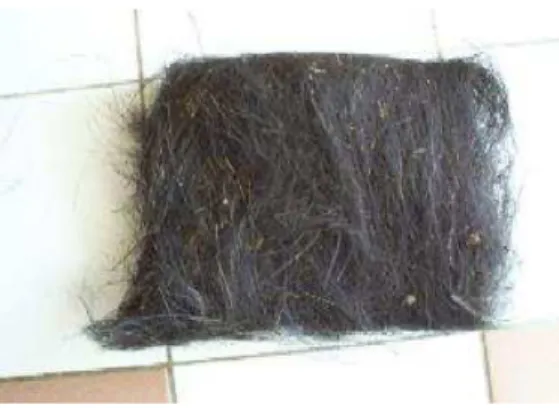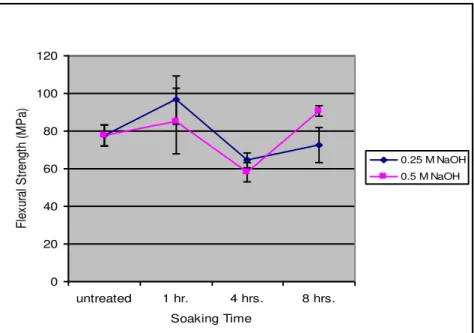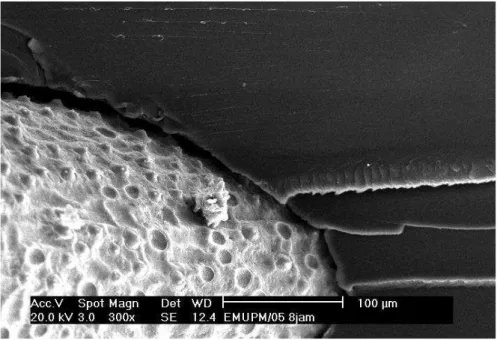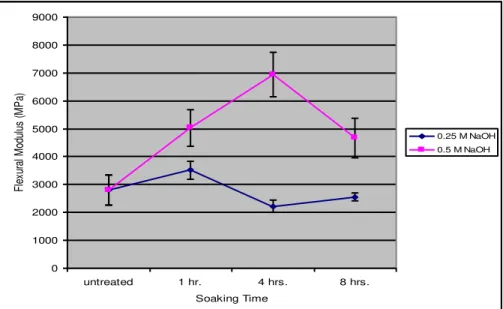79
FLEXURAL PROPERTIES OF ALKALINE TREATED SUGAR PALM FIBRE REINFORCED EPOXY COMPOSITES
D. Bachtiar, S.M. Sapuan and M.M. Hamdan
Department of Mechanical & Manufacturing Engineering, Faculty of Engineering, Universiti Putra Malaysia, 43400 UPM Serdang, Selangor, Malaysia
Tel.: +603-89466437. Fax: +609-87654321 E-mail: sapuan@eng.upm.edu.my
ABSTRACT
A study of the effect of alkaline treatment on the flexural properties of sugar palm fibre reinforced epoxy composites is presented in this paper. The composites were reinforced with 10% weight fraction of the fibres. The fibres were treated using sodium hydroxide (NaOH) with 0.25 M and 0.5 M concentration solution for 1 hour, 4 hours and 8 hours soaking time. The purpose of treating fibres with alkali was to enhance the interfacial bonding between matrix and fibre surfaces. The maximum flexural strength occurred at 0.25 M NaOH solution with 1 hour of soaking time, i.e 96.71 MPa, improving by 24.41% from untreated fibre composite. But, the maximum flexural modulus took place at 0.5 M NaOH solution with 4 hours soaking time, i.e. 6948 MPa, improving by 148% from untreated composite.
Key words: Arenga pinnata, flexural property, interfacial bonding, alkaline treatment.
INTRODUCTION
80
for the composites. These properties can be improved by physical treatments (cold plasma treatment and corona treatment) and chemical treatments (maleic anhydride, organosilanes, isocyanates, sodium hydroxide, permanganate and peroxide) (Wambua et al., 2003). Rowell (1998) gave considerations for the selection of a fibre chemical treatment such as ability to react with hydroxyl groups, its toxicity, easy to removal after treatment, low boiling point liquid, effective at low temperature, and cost. Alkali treatment is also an alternative as many times these chemicals swell the cell wall matrix structure and give better penetration (Rowell, 1998).
Sugar palm fibre is a potential source of natural fibre from Arenga pinnata, a member of Palmae family. This plant commonly grows in tropical regions such as the Philippines, Malaysia and Indonesia. It is naturally a forest species. The full length of the trunk of an Arenga pinnata tree is completely covered by black fibre. This black fibre can be used for brooms, paint brushes, septic tank base filters, clear water filters, door mats, carpets, ropes, chair/sofa cushions, and for fish nests to hatch eggs (Suwartapraja, 2003). In certain regions, traditional application of ijuk includes handcraft for kupiah (Acehnese typical headgear used in prayer) and roofing for traditional houses in Mandailing, North Sumatera. The significance of the study is to try exploring the potential of the abundant natural resources from forests for use as a reinforcing fibre in composites. The use of sugar palm fibre also has an economical advantage if glass or carbon fibre can be replaced by this sugar palm fibre. Mechanical properties such as tensile properties, flexural properties, and morphological aspects of sugar palm fibre reinforced epoxy composites have been studied by Siregar (2005). The study of the mechanical properties of sugar palm fibre reinforced epoxy composites gave promising results. The results of flexural strength tests of sugar palm fibre reinforced epoxy composites indicated that the 10 wt% woven roving fibre has the highest value compared to other fibre contents and arrangements. The work of Siregar (2005) has shown that using sugar palm fibres as a reinforcement agent for the epoxy matrix has provided a new form of composite with good strength and rigidity.
Suriani et al. (2007) examined or studied the interfacial adhesion of tensile specimens of sugar palm fibre reinforced epoxy composites. The composite specimens were prepared at various fibre weights of 10%, 15% and 20% with different fibre orientations such as woven roving, long random and chopped random. Interfacial adhesion study of tensile strength specimens reveals that the woven roving fibre composites gave good interface adhesion between the fibre and the matrix as compared to long random and chopped random fibre reinforced epoxy composites. However, none of the earlier studies looked into the effect of alkaline treatment of fibre on flexural properties of the composites and therefore, such a study is presented in this paper.
MATERIALS AND METHODS
81
to reduce the dirt resulting from the retting process. Before using the sugar palm fibre, it was dried for about two weeks at room temperature. Figure 1 shows the bundle of sugar palm fibres. The chemical treatment solution was sodium hydroxide (NaOH) commercially supplied by Fisher Chemicals Co. This solution was prepared in liquid form in the bottle with a concentration of 1 M.
Figure 1: Bundle of sugar palm fibres
(a) before fibre loading (b) after fibre loading
Figure 2: The process of making a specimen
The alkaline treatment was conducted with concentrations of 0.25 M and 0.5 M NaOH, at three different soaking times, namely, 60 minutes, 4 hours and 8 hours. These variations were made to optimize the treatment parameter. The concentrations were ensured by the addition of water at certain percentages of the original NaOH (1 M). Sugar palm fibres were immersed in NaOH solution at various concentrations and soaking times, and after that they were rinsed with distilled water until the rinsed solution reached neutral (pH 7). Then, the fibres were dried at room temperature for 4 days. The mould for preparing the specimens with hand lay-up technique was made of composite boards with the dimensions of 200 mm (L) x 150 mm (W) and a thickness of 3.2 mm. The required equipment for making the mould for the hand lay up process were glass, transparent plastics for the bottom layer, and a spacer frame.
82
over the transparent plastic in the bottom of the mould prepared earlier. Figure 2 shows the mould before and after fibre loading.
First, epoxy and hardener were mixed together based on the weight percentage to form a matrix, and then the matrix was poured over the fibre and compressed and distributed evenly until it achieved the thickness of between 3.0 mm and 3.2 mm. After that, the remaining mixture of epoxy resin and hardener was poured over the unfinished composite plate and then pressed and pushed down with a finger to remove the bubbles. The optimum way to ensure good curing to produce a standard quality specimen was by mixing the epoxy and hardener for approximately 10 minutes. The curing time was around 20–24 hours applied at the room temperature condition of 25–30 °C until the composite plate dried evenly. For the sugar palm epoxy composites, flexural properties such as flexural strength and flexural modulus were determined. Each composite board was cut into test samples (three or four specimens for each type of fibre model were tested). The cutting process used a handsaw and other equipment (jigsaw). The dimension of the specimen used to carry out test was adapted from ASTM D790-99 (2000) for flexural testing. All these tests were carried out for untreated and treated sugar palm fibre reinforced epoxy composites.
Flexural tests were performed on a universal testing machine (Instron 5566) using the 3-point bending method according ASTM D790-99 (2000). The specimen dimensions were 127 mm (L) x 12.7 mm (W) and 3.2 mm thickness. The specimens were tested at a crosshead speed of 5 mm/min. The bending stress is calculated from the measured load, as follows:
2 max
2 3
bd PL
(1)where,
max = flexural strength, P = load at yield (max. load), L = support span (mm), b = width (mm), d = thickness (mm).
Finally, an SEM micrograph PHILIPS was used to identify the fracture morphology of the composite samples and verify what happened in the interface between the fibre and matrix after stress loading.
RESULTS AND DISCUSSION
83
Table 1: The flexural properties of a sugar palm fibre reinforced epoxy composite
No. Type Strength Modulus
MPa MPa
1 no treatment 77.73 2805.23 mean
9.39 927.54 S.D.
2 0.25 M / 1 hr 96.69 3510.54 mean
22.14 566.25 S.D.
3 0.25 M / 4 hrs 64.42 2213.25 mean
6.47 381.66 S.D.
4 0.25 M / 8 hrs 72.63 2548.92 mean
16.27 242.52 S.D.
5 0.5 M / 1 hr. 85.30 5028.92 mean
30.17 1146.42 S.D.
6 0.5 M / 4 hrs. 58.17 6947.88 mean
8.97 1389.59 S.D.
7 0.5 M / 8 hrs. 90.68 4672.49 mean
5.00 1227.32 S.D.
S.D. is standard deviation
Flexural Strength
84 0 20 40 60 80 100 120 untre ated 0.25 M -
1hr.
0.25 M -
4hrs.
0.25 M -
8hrs.
0.5M - 1h
r.
0.5M - 4h
rs.
0.5M - 8h
rs.
The Type of Treatment
F le x u ra l S tr e n g th ( M P a )
Figure 3. The flexural strength of sugar palm epoxy composites for untreated and alkaline treated.
0 20 40 60 80 100 120
untreated 1 hr. 4 hrs. 8 hrs.
Soaking Time F le xu ra l S tr en gt h (M P a)
0.25 M NaOH
0.5 M NaOH
85
(a) untreated composites (b) 0.25 M alkaline treated for 1 hour
(c) 0.25 M alkaline treated for 4 hours (d) 0.25 M alkaline treated for 8 hours
(e) 0.5 M alkaline treated for 1 hour (f) 0.5 M alkaline treated for 8 hours
86
(a) (b) (c)
Figure 6: The surface of fibre for 1, 4 and 8 hours soaking time
Alkaline treatment also significantly changes the strength properties of individual natural fibre. Edeerozey et al. (2007) reported their study on the effect of a high concentration of alkaline solution on kenaf fibre. From the fibre bundle test, fibre treated with 6% NaOH show the maximum value of strength, and when the NaOH concentration is increased to 9%, the average of strength has shown a significant decrease. Hence, the combination between the strength characteristics of the fibre and characteristics of interfacial bonding between fibres and matrix contribute to yield the final flexural strength of the composites.
87
Figure 7: The surface of the 0.5 M / 8 hrs. treated sugar palm fibre on epoxy matrices
Figure 8: The surface of the 0.25 M / 8 hrs. treated sugar palm fibre on epoxy matrices
Flexural Modulus
88 0 1000 2000 3000 4000 5000 6000 7000 8000 9000 untre ated 0.25 M -
1hr.
0.25 M -
4hrs .
0.25 M -
8hrs .
0.5M - 1h
r.
0.5M - 4h
rs.
0.5M - 8h
rs.
T he T ype of T reatment
Fl ex ur al M od ul us (M P a)
Figure 9: The flexural modulus of sugar palm epoxy composites for untreated and the alkali treated. 0 1000 2000 3000 4000 5000 6000 7000 8000 9000
untreated 1 hr. 4 hrs. 8 hrs.
Soaking Time Fl ex ur al M od ul us (M P a)
0.25 M NaOH 0.5 M NaOH
Figure 10: Average flexural modulus of sugar palm fibre reinforced epoxy composite vs. soaking time
89
CONCLUSIONS
It can be concluded that the maximum flexural strength (96.71 MPa) of the composite is for the alkali treatment of 0.25 M alkali solution and 1 hr soaking time. Under that condition, the increase of flexural strength from the untreated sample is about 24.41%. But, the maximum flexural modulus took place as a result of the 0.5 M NaOH solution with 4 hours soaking time, i.e. 6948 MPa, an improvement of 148% from the untreated fibre composite. The high concentration of the alkali treatment provides for increasing of the flexural modulus significantly. It may be caused by the alkaline effect on fibres that increases their crystallinity.
ACKNOWLEDGEMENTS
The authors are indebted to staff at the Faculty of Engineering and Faculty of Forestry, Universiti Putra Malaysia and Malaysian Nuclear Agency (MNA) for their support.
REFERENCES
ASTM D790-99. (2000) Standard test method for flexural properties of unreinforced and reinforced plastics and electrical insulating materials. USA: American Society for Testing Materials.
Bledzki, A.K. and Gassan, J. (1999) Composites Reinforced With Cellulose Based Fibres. Progress in Polymer Science, 24: 221–274.
Cao, Y., Shibata, S. and Fukumoto, I. (2005) Press Forming Short Natural Fiber-Reinforced Biodegradable Resin: Effect of Fiber Volume and Length on Flexural Properties. Polymer Testing, 24: 1005–1011.
Edeerozey, A.M.M., Akil, H.M., Azhar, A.B. and Ariffin, M.I.Z. (2007) Chemical Modification of Kenaf Fibres. Material Letters, 10: 2023–2025.
Herrera-Franco, P.J. and Valadez-Gonzalez, A. (2004) Mechanical Properties of Continuous Natural Fibre–Reinforced Polymer Composites. Composites Part A: Applied Science and Manufacturing, 35: 339–345.
Rong, M.Z., Zhang, M.Q., Liu, Y., Yang, G.C. and Zeng, H.M. (2001) The Effect of Fiber Treatment on the Mechanical Properties of Unidirectional Sisal Reinforced Epoxy Composites. Composites Science and Technology, 61: 1437–1447.
Rowell, R.M. (1998) Property Enhanced Natural Fibre Composite Material Based on Chemical Modification. in: Science and Technology of Polymers and Advanced Materials, Prasad, P.N. (Ed.). New York: Plenum Press, pp. 717–732.
Saheb, N.D. and Jog, J.P. (1999) Natural Fibre Polymer Composites: A Review. Advanced Polymer Technology, 18: 351–363.
Siregar, J.P. 2005. Tensile and Flexural Strength of Arenga pinnata Filament (Ijuk Filament) Reinforced Epoxy Composites. Master of Science thesis. Universiti Putra Malaysia.
Suriani, M.J., Hamdan, M.M., Sastra, H.Y. and Sapuan, S.M. (2007) Study of nterfacial Adhesion of Tensile Specimens of Arenga Pinnata Fiber Reinforced Composites, Multidiscipline Modeling in Material and Structure, 3(2): 213–224. Suwartapraja, O.S. (2003) Arenga pinnata: A Case Study of Indigenous Knowledge on
the Utilization of a Wild Food Plant in West Java.
90
Wambua, P., Ivens, J. and Verpoest, I. (2003) Natural Fibres: Can They Replace Glass in the Fibre-Reinforced Plastics? Composites Science and Technology, 63: 1259–1264.






